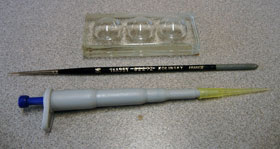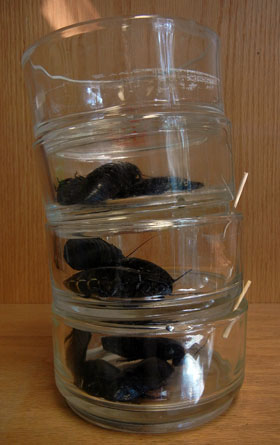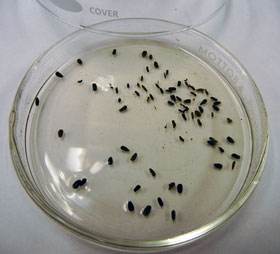Collecting gametocysts
Tools and solutions
The basic tool kit for collecting gametocysts includes a deep 3-well dish for collecting, sorting, and washing gametocysts, a small, fixed volume pipette (20-40 microliters) with disposable tips, and a fine paintbrush. A number 000 watercolor brush works well and is relatively inexpensive. A 00 or 000 Kolinsky sable liner is excellent but pricey. (However, good brushes last if you take care of them. I paid about $25 for a kolinsky sable brush in the early 1990's but I'm still using the same brush.)
Field collection
Field collecting gametocysts is largely opportunistic. If a sufficient number of hosts have been collected, gametocysts can be collected as described under "laboratory collection", below. If host numbers are limited, gametocysts can be collected from the hind gut while dissecting to make slide preparations. In our experience, this approach generally produces gametocysts sufficient to complete taxonomic studies but not enough to conduct extensive empirical studies. Gametocysts collected during dissection should be triple rinsed by pipetting through water-filled wells in a three well dish. Gametocysts can be stored and incubated to produce oocysts using laboratory or field variants of the basic technique.
Laboratory collection
Given sufficient host numbers, collecting gametocysts begins by collecting host feces. Most hosts can be isolated in an appropriately sized Carolina culture dish overnight to collect feces. Flying insects such as damselflies can be isolated posterior end down in disposable plastic test tubes with 10-12 mm of water in the bottom. Dry feces should be rehydrated in an excess volume of saline or water for an hour or so to soften fecal pellets and allow gametocysts to be freed from feces. A fine brush is used to break up individual fecal pellets and sort gametocysts. Collected gametocysts are triple rinsed by pipetting through water-filled wells in a three well dish. Gametocysts can be stored and incubated to produce oocysts using laboratory or field variants of the basic technique.



